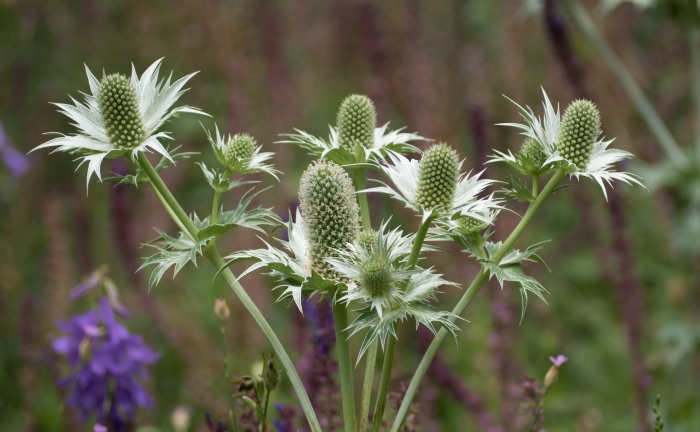Miss Willmott’s Ghost
(Eryngium giganteum)
Miss Willmott’s Ghost (Eryngium giganteum)
/
/

Rhododendrites
CC BY-SA 4.0
Image By:
Rhododendrites
Recorded By:
Copyright:
CC BY-SA 4.0
Copyright Notice:
Photo by: Rhododendrites | License Type: CC BY-SA 4.0 | License URL: https://creativecommons.org/licenses/by-sa/4.0 | Uploader: Rhododendrites | Publisher: Wikimedia Commons | Title: Sea_holly_(71611).jpg | Notes: == Summary == {{Information |Description=Erythrinia abyssinica |Source=http://www.mytho-fleurs.com/ |Author=Bernard Loison |Permission=yes }} [[Category:Fabaceae|Erythrinia]] == Licensing == {{cc-by-sa-2.5}} |



















Estimated Native Range
Summary
Eryngium giganteum, commonly known as Miss Willmott’s Ghost, is a deciduous perennial herb native to rocky and coastal areas, grasslands, and dry hillsides in the Caucasus and Turkey. It typically grows to a height of 1 meter (3 feet 3 inches). This plant is characterized by its striking architectural form, with branched heads of pale green conical flowerheads surrounded by spiny, silver-blue bracts that appear in summer. The flowers mature to an intense steel blue. Miss Willmott’s Ghost is particularly noted for its ghostly silvery-gray appearance, which is most pronounced in its second year, just before it sets seed and dies. It is often grown as a biennial due to its monocarpic nature, meaning it usually dies after flowering.
Miss Willmott’s Ghost is valued for its unique color and texture in the garden. It provides a strong vertical accent and is often used in borders, gravel gardens, and coastal plantings. Its dramatic presence is enhanced when planted against a dark background or in mass plantings. The plant prefers full sun and is drought-tolerant once established, requiring only moderate watering. It thrives in well-drained soil and is relatively low-maintenance. The cultivar ’Silver Ghost’ is especially prized for its more pronounced silvery hue. While generally disease-free, it can occasionally suffer from root rot if kept in poorly drained soils. It is also resistant to deer and rabbits, making it a good choice for areas with wildlife pressure.CC BY-SA 4.0
Miss Willmott’s Ghost is valued for its unique color and texture in the garden. It provides a strong vertical accent and is often used in borders, gravel gardens, and coastal plantings. Its dramatic presence is enhanced when planted against a dark background or in mass plantings. The plant prefers full sun and is drought-tolerant once established, requiring only moderate watering. It thrives in well-drained soil and is relatively low-maintenance. The cultivar ’Silver Ghost’ is especially prized for its more pronounced silvery hue. While generally disease-free, it can occasionally suffer from root rot if kept in poorly drained soils. It is also resistant to deer and rabbits, making it a good choice for areas with wildlife pressure.CC BY-SA 4.0
Plant Description
- Plant Type: Herb
- Height: 2-4 feet
- Width: 1-3 feet
- Growth Rate: Moderate
- Flower Color: Blue, White
- Flowering Season: Summer
- Leaf Retention: Deciduous
Growth Requirements
- Sun: Full Sun
- Water: Medium
- Drainage: Medium
Common Uses
Bee Garden, Bird Garden, Butterfly Garden, Deer Resistant, Drought Tolerant, Low Maintenance, Rabbit Resistant, Rock Garden, Salt Tolerant
Natural Habitat
Rocky and coastal areas, grasslands, and dry hillsides in the Caucasus and Turkey
Other Names
Common Names: Tall Eryngo, Giant Sea-Holly, Miss Willmot’s-Ghost, Riesen-Mannstreu, Elfenbein-Mannstreu, Panicaut Géant, Silvermartorn, Gravatá-Grande
Scientific Names: , Eryngium giganteum, Eryngium asperifolium, Eryngium glaucum, Eryngium haussknechtii,
GBIF Accepted Name: Eryngium giganteum M.Bieb.